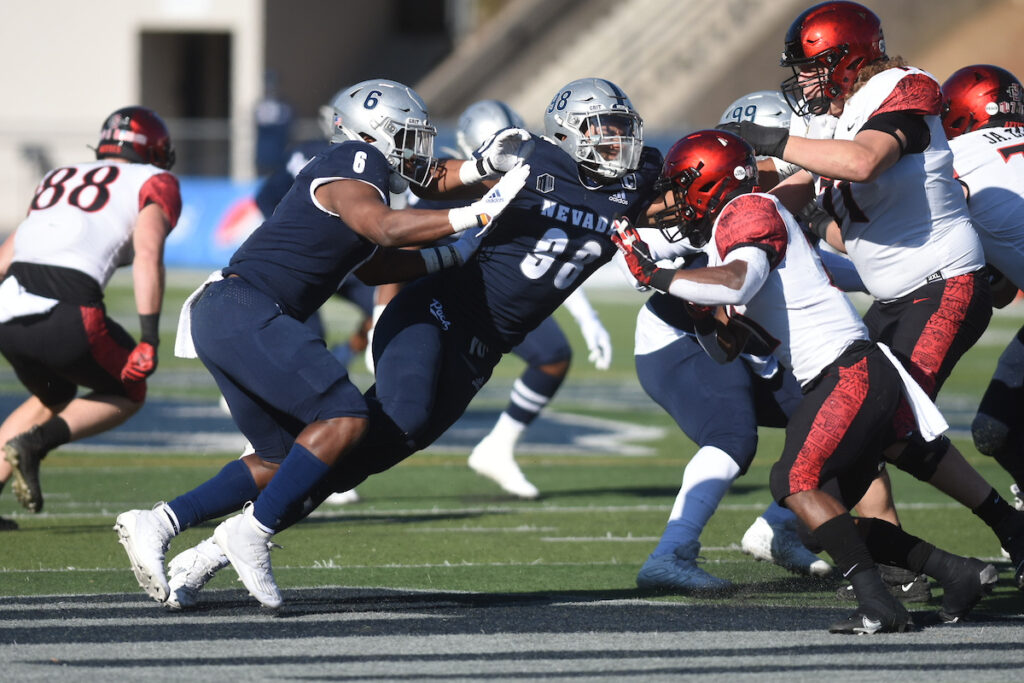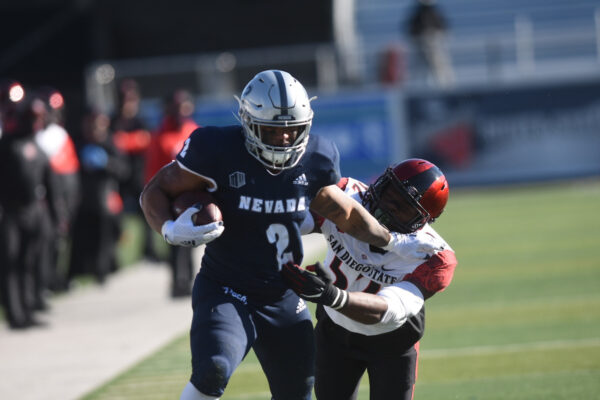Report Card: SDSU vs Nevada

Credit: Nevada Athletics

A second loss on the season ended the Aztecs’ hope of a winning a conference championship.
A game of two halves, the Aztecs’ offense under the leadership of Lucas Johnson looked better and balanced than any in recent memory in the first half, only to completely disappear in the second half. A late-game interception gave SDSU a chance to win, but Johnson and the offense could not capitalize on the turnover.
Offense
Quarterback: B-
Expectations are the name of the game. Coming into the game, Johnson was expected to keep the defense honest by running the read option and throwing just enough to prevent Nevada from completely selling out to stop the run. By half time, based on Johnson’s unbelievable performance, expectations had completely changed. Johnson was being anointed the next Jalen Hurts, whose running and passing ability was nothing the Mountain West had ever seen. In the second half, Johnson came back to earth. Cramping and a slight hamstring injury hampered his ability to run, and SDSU was not able to complete the play action passes that was so effective in the first half. Johnson, though, showed something no SDSU Quarterback since Ryan Lindley had: brilliance running the offense, which gives hope for the future of the position especially with the thought Johnson might be here for two more seasons since the NCAA granted an extra year of eligibility because of Covid’s impact on the season.
Running Back: D
Jeff Horton’s bio brags about the starter in his running back group earning all-conference honors each year he has been the coach until last season. Ronnie Hillman, Adam Muema, Donnel Pumphrey, Rashaad Penny, and Juwan Washington were all lightly recruited players. Pumphrey’s scholarship offer to attend Duke was the only Power Five offer between them. Their success opened up doors into houses of the higher-rated running backs. Chase Jasmin had offers from Washington and Arizona. Jordan Byrd had offers from Arizona and Utah, Kaegun Williams had offers from Colorado, Cal, and Tennessee. Yet, each of these players has proven to be complementary players. The top two running backs this season, Greg and Chance Bell, had no Power 5 offers coming out of high school.
With Nevada stacking the box against the Aztecs and Greg Bell slowed by injury, the running backs could get little going. Like Hawaii last week, the Wolf Pack attacked the Aztecs stretch plays, but Greg Bell is the only running back on the roster with the vision to consistently take advantage of the lanes caused by over pursuing defenses.
Wide Receiver: C
A dropped pass by Elijah Kothe on the first drive of the second half was an omen of the poor half to come. Saturday was Kothe’s most impactful game of the season as he showed chemistry with Johnson not seen between him and Baker. Johnson’s ability to throw Kothe opened was the key to the Aztec’s early success. Jesse Matthews again paced the Wide Receivers with five catches for 80 yards. Kobe Smith also caught a touchdown.
Tight End: C+
A graduate transfer, Nolan Givan, was brought over from Ball State this season because of his skill as a blocker. During the first half of the game, Givan played consistently as basically a fullback. He skillfully found and blocked the extra defender Nevada brought. Noticeably absent for much of the second half when SDSU decided to spread the field, Givan continues to be an unsung hero for the team.
Daniel Bellinger, a tremendous blocker in his own right, caught a pair of passes. His final reception brought the Aztecs to first and goal. In a game this close, wondering what could have been is a normal reaction. If Johnson had found Bellinger immediately when he opened up, there was a good chance, the athletic and powerful, tight end would have found the end zone.
Offensive Line: B
There are multiple ways to attack defenses that stack the box against an opposing offense. SDSU employed two on Saturday. One option is to match the number of players defenses bring to the line of scrimmage; another is to spread the offense out and use the quick throwing game to march down the field. Though it is a small sample size. the former seems to fit Lucas Johnson’s skill set best, and it also helps the offensive line effectiveness. When SDSU spread out the offense, it placed a lot of pressure on the offensive line to pick up the correct defensive player. If they blocked the wrong player or got beat, there was no one behind them in support. Early in the game, the play-action pass was key as it kept more players inside to block for the pass. The offensive line played well, considering they were often outnumbered as Nevada dared the Aztecs to pass the ball.
Defense
Defensive Line: B-
Nevada’s offense was designed to spread the defense out and use the short passing game to move the ball with occasional deep passes to keep their opponent from jumping the underneath routes. SDSU countered that by trusting its lineman to get pressure on the quarterback. For the most part, the defensive line did its job. The passes were released quickly, so there were no sacks in the game, but Cameron Thomas and Jonah Tavai combined for five QB Hurries. As importantly, they were tasked with stopping the run game despite being outnumbered, and they were successful. Nevada ran for 91 yards on 23 carries.
Linebacker: C+
Following the game, SDSU Head Coach singled out defensive penalties and missed interceptions as the missed chances made it difficult for SDSU to walk away with a victor. Hoke did not single him out by name, but Caden McDonald was in the center of these bad plays. Halfway through the second quarter, Nevada faced a third and ten from their own 14. They trailed 14 – 9 at the time. McDonald flushed Carson Strong out of the pocket, forcing an incomplete pass but inexplicably bumped into the Strong well after the pass was thrown, resulting in a penalty and a first down. Had he kept his composure, the offense would have had a chance to work with good field position. Four snaps later, McDonald blocked Strong’s pass into the air, and instead of jumping to catch the interception at its peak, McDonald waited until the ball reached his chest. He caught the ball, but because it was so low, a Nevada player was able to knock it out of his hands.
Cornerback: B+
When the 3-3-5 is working well, it puts tremendous pressure on the corners to play one on one against opposing wide receivers. The trade-off is it creates the opportunity for turnovers. Darren Hall was on an island all game. He was not perfect – he gave up two long pass plays – but he also came up with the big turnover that, had it not been for a blown pass at the goal line, would have resulted in an Aztec win. Tayler Hawkins started and was solid, if unspectacular, throughout the game.
Safety: Paul: B-
Dwayne Johnson Jr was missing from the game attending to the death of a loved one. In his place, Patrick McMorris played well, though Johnson’s presence was missed. Tariq Thompson was terrific as usual, coming up not just with stops, but pressure stops when needed. The safety group, however, did not make enough key plays to get the ball back to the offense. Patrick McMorris dropped an interception in the end zone but played a terrific game in his first start.
Special Teams: (as a whole) C+
With only a couple of games remaining on the season, it is doubtful the unit is going to correct the problems that have shown up week after week. Tanner Kuljian had trouble handling a couple of snaps at holder. Jesse Matthews did not fumble a punt; however, he misjudged two punts, the latter of which put SDSU in terrible field position late. The punt defense gave up over 15 yards a punt return.
The positives for the unit included Matt Araiza not allowing a return on four kickoffs and making all three extra points despite the problems with the hold. Tanner Kuljian averaged 52.5 yards on eight punts and landed two inside the 20. Jordan Byrd had a nice kickoff return of 34 yards.
Coaching: D-
One of the many subtleties missing from a season without fans is the “Double Your Score” chant employed by the Show, no matter if the score is 8 – 4 or 100 – 50. The chant is a fitting description when comparing SDSU’s first half and second half scoring. Their 96 first-half points are double their score in the second, 48. While this speaks volumes about the lack of second-half adjustments by Jeff Hecklinski and the offensive staff, the story is even more compelling when you consider the offense scored 28 second-half points against Utah State. In every other game, the Aztecs are averaging less than a touchdown in the second half.
Brady Hoke’s decision to call a timeout late in the first half to force his suspect punting team to field a punt was a head-scratcher. Jesse Matthews made a spectacular, over the shoulder, fair catch at the SDSU 12 yard line. Hoke wisely chose to kneel the next play to end the half. He could have simply allowed Nevada to have done that and not risked the punts.
Referees: C+
Timothy Davis and his crew did not have the best game, but they also did not play too big a part in the game’s outcome. Generally speaking, referees should not make calls when they are across the field. Too often on Saturday, the ref closest to the play would not throw a flag, but another would who was many yards away. Nevada was only called for two non-False Start penalties. The Aztecs were called for six.
My earliest sport’s memory involve tailgating at the Murph, running down the circular exit ramps, and seeing the Padres, Chargers and Aztecs play. As a second generation Aztec, I am passionate about all things SDSU. Other interests include raising my four children, being a great husband and teaching high school.